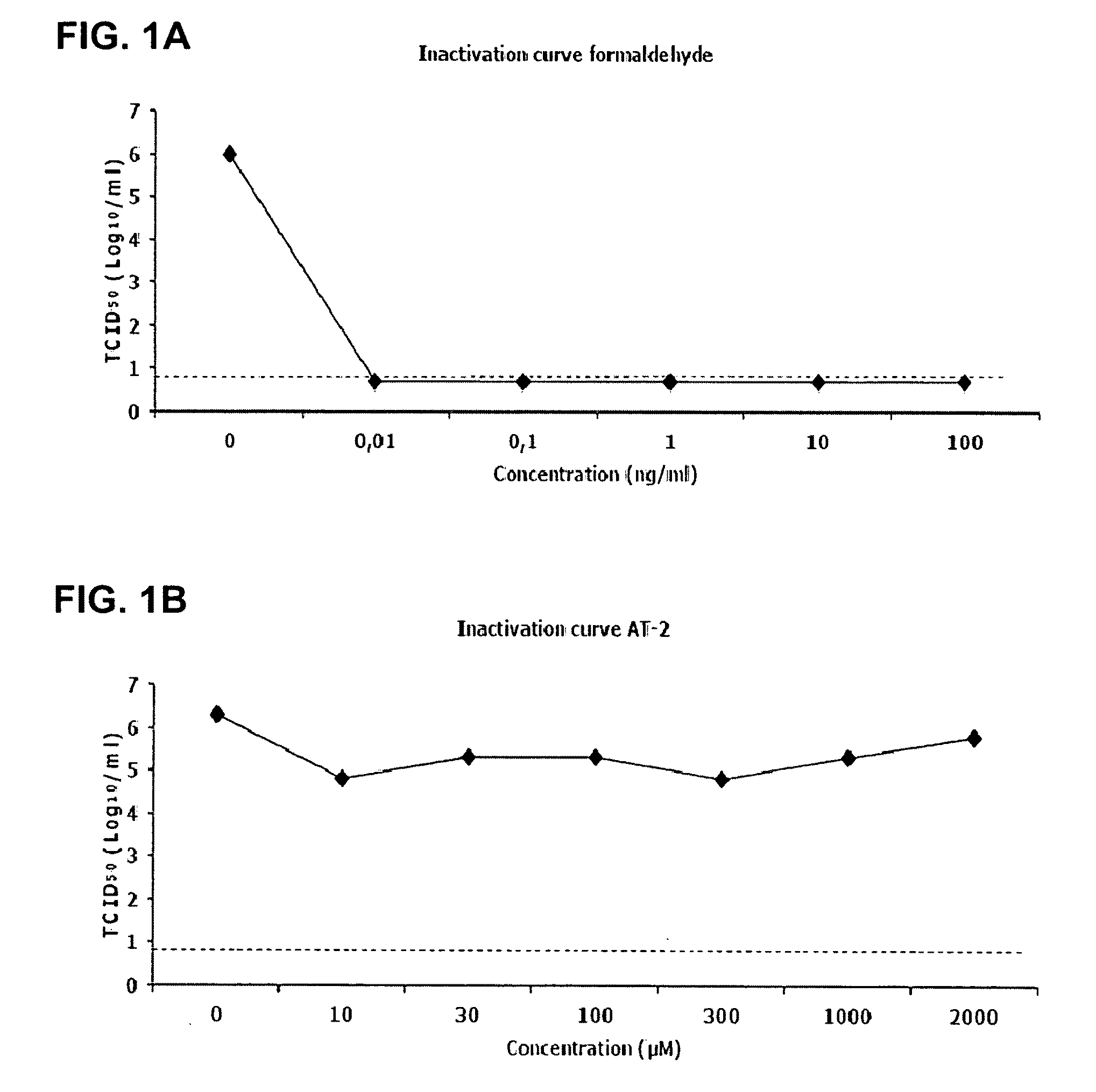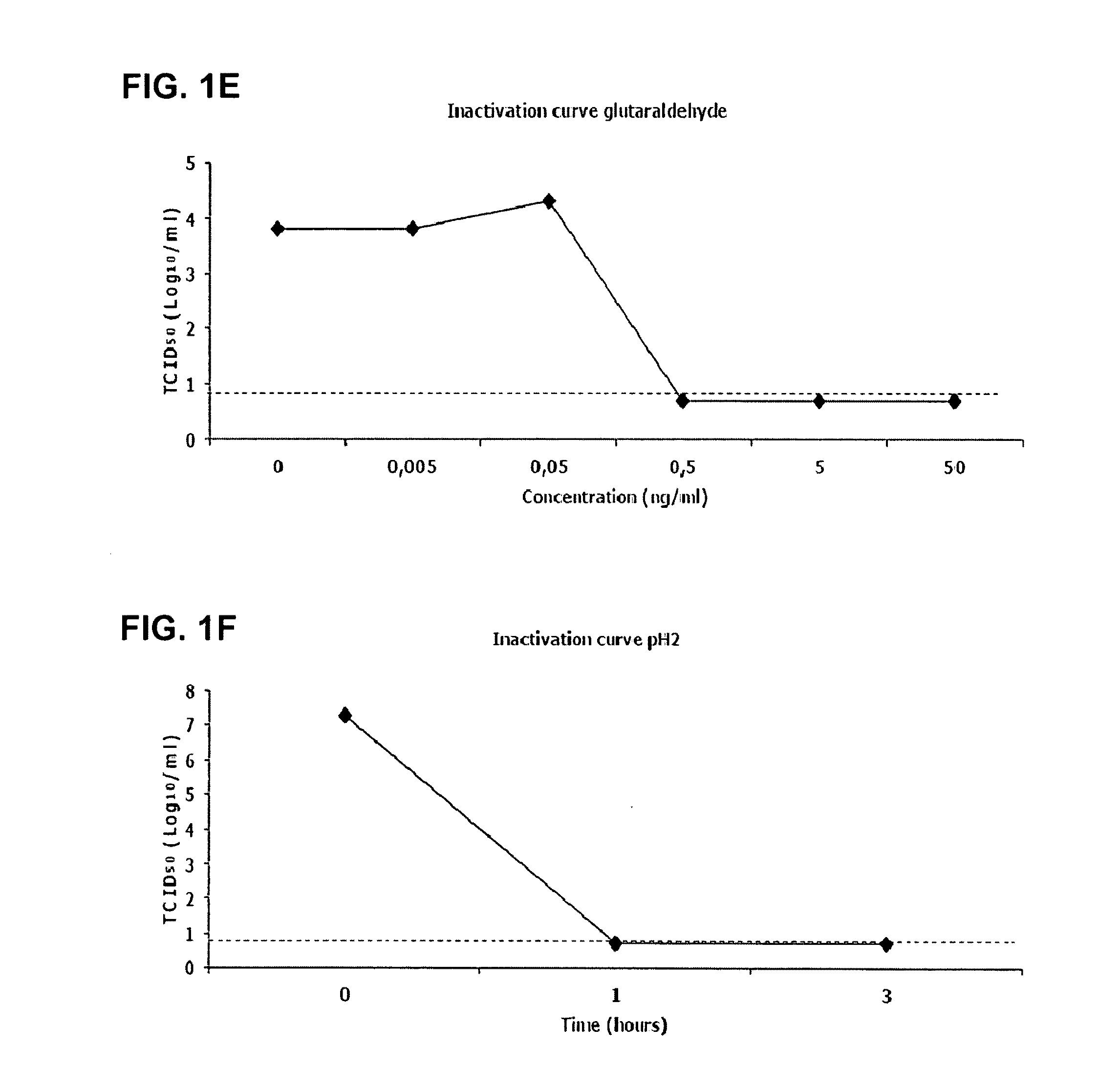Viral inactivation process
a technology of inactivation process and virus, applied in the field of virology, can solve the problems of reproductive disorders in sows, unsatisfactory treatment of prrsv by either method, and insufficient safety of use, so as to reduce viremia post-infection and protect the immune respons
- Summary
- Abstract
- Description
- Claims
- Application Information
AI Technical Summary
Benefits of technology
Problems solved by technology
Method used
Image
Examples
example 1
In Vitro Analysis of the Effect of Virus Inactivation Procedures on PRRSV Epitopes Involved in Virus Entry
Materials and Methods
1.1 Cells and Virus
[0090]The European strain Lelystad virus (LV) of PRRSV (Wensvoort et al., 1991) grown on MARC-145 cells (5th passage) was used for inactivation. MARC-145 cells cultivated in minimum Eagle's medium (MEM) with 5% FCS, 1% glutamine, 1% penicillin-streptomycin and 1% kanamycin were used for LV production and titration of inactivated virus. Attachment and internalization of the inactivated virus was investigated in macrophages that where cultivated in medium containing RPMI 1640, 10% FCS, 1% penicillin-streptomycin, 1% kanamycin, 1% gentamycin, 1% tylosin, 1% glutamine, 1% nonessential amino acids and 1% sodium pyruvate for 24 hours before inoculation. When CHO cells were used, the cells were cultivated in F12 with 10% FCS, 1% penicillin-streptomycin, 1% kanamycin, 1% glutamine, and 1% sodium pyruvate and were transfected with sialoadhesin. As ...
example 2
Results of BEI Inactivation (0-90 mM)
Introduction
[0124]In the previous example, we investigated if BEI could inactivate PRRSV with preservation of the neutralizing viral epitopes in vaccine development. Therefore, PRRSV was inactivated with 1 mM BEI for different durations (0-6-12-24-48 and 72 hours). The results showed that BEI could inactivate PRRSV with preservation of neutralizing epitopes because the inactivated virus could still bind and internalize in macrophages, the target cell of PRRSV.
Aim
[0125]In the present study, we wanted to investigate if PRRSV that is treated with higher concentrations of BEI could still bind and internalize in macrophages and CHO cells that express sialoadhesin (CHOSn). If higher concentrations would block PRRSV attachment and internalization, this would provide further proof for the need of a technique that assesses the effect of BEI inactivation and allows optimization.
Materials and Methods
[0126]Lelystad virus (LV), the European type of PRRSV, was...
example 3
Vaccination of Naïve Piglets
Materials and Methods
Virus Production and Purification
[0131]The PRRSV Lelystad virus (LV) strain, propagated on Marc-145 cells, was used for vaccine preparation (G. C. Wensvoort et al., 1991). Fifth passage cell culture supernatant was filtrated through a 0.45 μm filter and virus was concentrated from the supernatant by ultracentrifugation at 112,000 g for two hours using a Type 35 rotor (Beckman Coulter). Subsequently, virus was semi-purified by ultracentrifugation at 100,000 g for three hours through a 30% sucrose cushion, using a SW41Ti rotor (Beckman Coulter), resuspended in phosphate-buffered saline (PBS) and stored at −70° C. Before inactivation, virus was diluted in RPMI 1640 to a 50% tissue culture infectious dose (TCID50) of 108 per ml. Challenge virus consisted of fifth passage cell culture supernatant of the PRRSV LV strain, propagated on porcine alveolar macrophages (PAM), derived from gnotobiotic piglets.
[0132]Inactivation o...
PUM
| Property | Measurement | Unit |
|---|---|---|
| temperature | aaaaa | aaaaa |
| molecular weight | aaaaa | aaaaa |
| concentrations | aaaaa | aaaaa |
Abstract
Description
Claims
Application Information
 Login to View More
Login to View More - R&D
- Intellectual Property
- Life Sciences
- Materials
- Tech Scout
- Unparalleled Data Quality
- Higher Quality Content
- 60% Fewer Hallucinations
Browse by: Latest US Patents, China's latest patents, Technical Efficacy Thesaurus, Application Domain, Technology Topic, Popular Technical Reports.
© 2025 PatSnap. All rights reserved.Legal|Privacy policy|Modern Slavery Act Transparency Statement|Sitemap|About US| Contact US: help@patsnap.com



